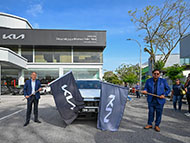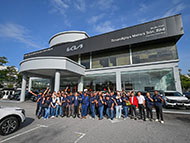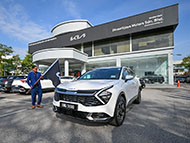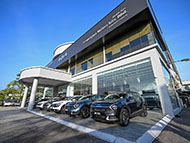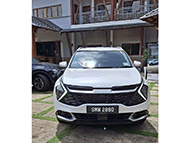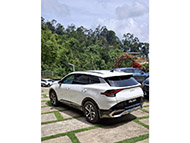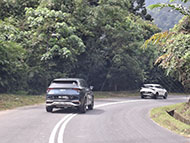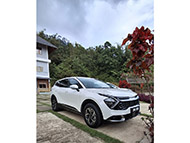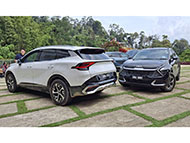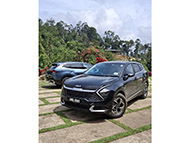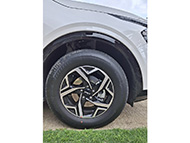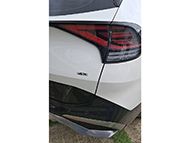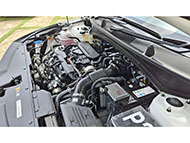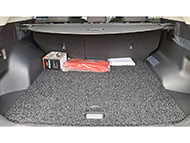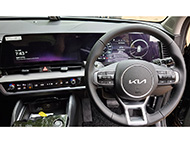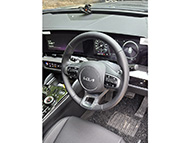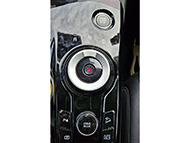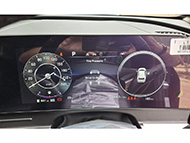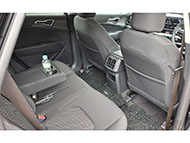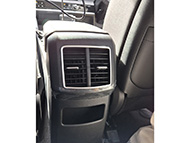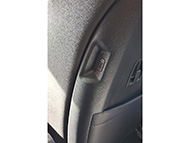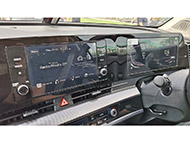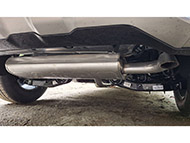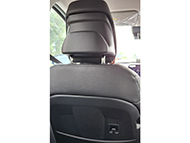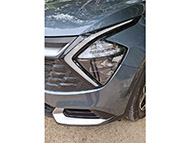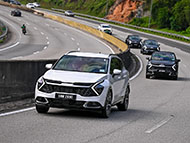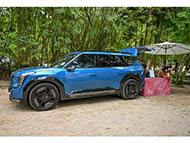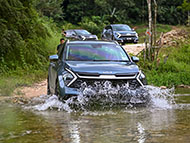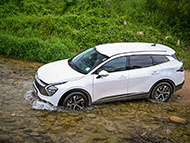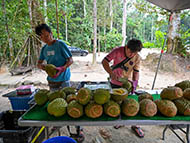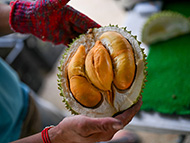By Lee Pang Seng
THE latest Kia Sportage is making a big splash to open 2025 with striking options to capture potential customer attention. The mid-range SUV (sport utility vehicle) comes with bold new looks to captivate the onlooker and bigger body dimensions without looking clumsy nor unwieldy.
Kia has adopted LED (light emitting diode) headlamps styled somewhat along a boomerang with greater curvature that gives it a distinct ‘face’. You need to stand out among the crowd in this highly competitive sector and with this curvaceous headlamp, it would be easy to pick out the latest Sportage on the road.
The Sportage carries the Kia characteristic grille in a fresh outline, topped by a broad chrome strip with a lower grille panel in body colour. The designers have softened this front styling outlook so that it’s less forward than as in previous models but distinct enough to establish its Kia lineage.
By contrast, the rear seems rather bland with the unassuming rear light clusters joined by a thin strip. There is an ‘open mouth’ design with a black panel enveloping the vehicle’s number plate section and a light grey under panel serving as the lower lip. This was more visually obvious in the white Sportage that we drove.
An interesting note here is that Kia has chosen not to go for the double exhaust tailpipe styling that is common in many passenger vehicles today. There is instead a single rear exhaust with a downward facing tailpipe. It is tucked away behind the light grey panel, leaving many to believe this is an EV (electric vehicle), which does not have exhaust tailpipes.
But the Sportage is no EV being an ICE (internal combustion engine) mid-range SUV. Kia distributor Dinamikjaya Motors Sdn Bhd has two engine options – 2.0-litre normally aspirated and 1.6 turbo - with two model variants each. The former has the normal and high spec versions while the turbo comes in either two-wheel drive (front wheel driven) or AWD (all-wheel drive) selection. These models are all locally assembled.
A media drive involving a variety of traffic and road conditions gave us an insight into what the latest Kia Sportage was all about. The route took us to part of the old winding road to Bentong, Janda Baik, Gohtong Jaya and Serendah before hitting the Latar highway back to Glenmarie. There was a slight diversion to a camping site in Serendah with some ‘off-road’ sections that were more suited to pick-ups rather than SUVs.
Before we delve into more of the latest Sportage, here’s a bit of this SUV’s background. It started off in 1993 as an adaptation of a Mazda model before evolving into its own from the third-generation model in 2010. It’s now into its fifth generation (since 2021) and holds the honour of being Kia’s best-selling model in the current times.
The 2.0-litre (1999cc) engine in the models sold here delivers 113kW (154hp) at 6200rpm and 192Nm at 4500rpm. Power goes to the front wheels via s six-speed automatic transmission. The 1.6-litre (1598cc) Gamma II T-GDI turbocharged engine offers more with 130kW (177hp) at 5500rpm and 265Nm torque that peaks early at 1500rpm and plateaus till 4500rpm. It features a seven-speed DCT (e-shift).
Out first drive impression was in the 2.0-litre High-spec Sportage. This model offers the driver the convenience of eight-way electric seat adjustments and leatherette seat upholstery. There are two eight-inch visual monitors on the dashboard; one for the multi-info display with touchscreen access in the centre and the instrument panel for the driver.
As a high-spec model, there are four USB ports (two of them located on the inner side of the front seats) – one Type A and three Type C – although the coat hangers behind the front seats are standard design for all models. This is complemented by a smaller hook lower down the rear of the front passenger seat.
On the go, the 2.0-litre engine fared reasonably well though we needed to prompt the accelerator harder to achieve some quick overtaking. At times, we felt that the transmission was a CVT (continuously variable transmission) as the engine roar on kickdowns was somewhat similar. Perhaps the ratios for the six-speed automatic could be better selected to complement the 2.0-litre engine output.
Moreover, the new Sportage is on the heavy side with a kerb weight of 1578kg and we also had three people on board. This might have led to the engine having to work harder to build up the revs and power to get going quickly, especially for overtaking.
It was along the old winding stretch to Bentong that we enjoyed driving the new Sportage the most. Its suspension system – MacPherson struts in front and multi-links at the rear – appeared well sorted out to let us explore a fair bit of its dynamic limits. Steering feedback was good, giving us a good idea of where the front wheels were pointing as we took to the corners with some abandon.
For a taller vehicle, body lean was there but the anti-roll bars front and rear did their stuff well by checking the body roll within expectations. The 2,0-litre models are fitted with 17-inch alloys fitted with Hankook Dynapro 235/65 R 17 tyres. A Tyre Pressure Monitoring System (TPMS) is a standard feature and we noticed that when we started the drive that tyre pressures weren’t exactly even all round, although the differences were small.
The ride over secondary roads was good as the bumps, potholes and speedbumps were taken with the respective impacts reasonably well suppressed and cushioned. We noted this more as a rear seat passenger, marvelling at the good legroom at the same time (the long wheelbase of 2755mm has a lot to do with this).
The rear seatrests could also be tilted a fair bit back for a siesta on long-distance drive as one of our media members did so during the drive. And the 400-litre plus luggage area would easily accommodate some big luggage for holiday drives. If more space is needed to transport some sizeable purchase from Ikea, the 60:40 split rear seatrests to expand space would come in handy.
The high-spec models come with the full suite of active safety measures and the 2.0 High that we drove reflected just that. It made warning sounds when we meandered out of our lane (due to the Lane Following Assist) and were approaching the vehicle in front too fast (Forward Collision Avoidance Assist).
A novel feature was the Turning Junction item that is part of the Forward Collision Avoidance Assist. By indicating left or right, the respective dial on the instrument panel (speedometer and tachometer) would display the approaching traffic on the desired side so you could turn in a safer way. The dial would resume their usual function once the indicator is turned off.
For the second part of the drive, we were assigned the 1.6 T High two-wheel drive. We preferred the power characteristics of this 1.6 turbo engine; what little perceived engine lag there was while moseying along was immediately forgotten when we hit the accelerator. The maximum torque of 265Nm that kicked in at 1500rpm gave us that quick pick-up-and-go thrill, especially for some quick overtaking. We could even spin the front wheels if we accelerated hard from standstill.
A big change was the slightly curved display screen on the dashboard combining the bigger 12.3-inch units that was meant to be driver focused. There is no T-bar gearshifter that we saw in the 2.0 High. Instead, there was a turn knob on the centre console to select the respective mode that is complemented by a Drive mode nearby. In Sport mode, we could use the paddle shifters on the steering wheel although the heavy traffic on the return stretch didn’t give us much of an opportunity to check that out.
The turbo models come with 18-inch alloys that were fitted with 235/60 R18 tyres. The firmer ride wasn’t quite noticed until we came to the secondary roads, including the short off-road stretch. We felt more of the road impacts and it certainly wasn’t comfortable going over speedbumps at higher than crawling speeds, for the rear passengers in particular.
We enjoyed the ride on the highway due to its relative quietness; the wind noise was largely unnoticed due to the efficient body aerodynamics and the road roar over the respective tarmac surfaces was also nicely curtailed. This allowed us to enjoy the music from the six-speaker system.
Being locally assembled SUVs, the latest Kia Sportage range is available at competitive prices, beginning from RM147,218.60 on the road with insurance for the mid-spec 2.0 model. The 2.0 High we drove is priced at RM157,218.60, up RM10,000. The 1.6T 2WD goes for RM179,599 and the 1.6T AWD is yours for RM189,599. Five-year free maintenance and warranty is part and parcel of the purchase.
